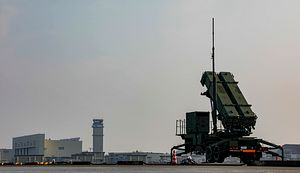As Japan prepares to release three critical security documents – its National Security Strategy, National Defense Program Guidelines, and Medium-Term Defense Program – by the end of 2022, its policymakers have been discussing Japan’s acquisition of strike capabilities in the context of missile defense. The debate about adopting “counterstrike capabilities” – formerly known as “enemy base strike capabilities” – accelerated exponentially when the ruling Liberal Democratic Party’s (LDP) Research Commission on Security proposed that Japan must consider acquiring such capabilities to deter missile attacks.
Although this active discussion reflects the severe regional security environment facing Japan, the strike capability debate must also be accompanied by decision-makers’ will to make a political decision about the conditions for deploying strikes and their commitment to launch counterstrikes against the enemy – including China – to improve Japan’s deterrence against missile attacks.
Under the current so-called “spear and shield” missile defense, Japan focuses on detecting/tracking ballistic missiles with radars operated under the Japan Aerospace Defense Ground Environment (JADGE), and then intercepting the missiles with two layers of defense. Japan’s Maritime Self-Defense Force (SDF) would intercept missiles from Aegis destroyers during the midcourse phase, and the Air SDF would intercept them with the PATRIOT Advanced Capability-3 (PAC-3) during the terminal phase. The U.S. forces, meanwhile, would provide Japan with information on missile launches detected with early warning satellites and carry out retaliatory strikes against the attacker.
The spear and shield missile defense is a highly sophisticated and effective system against North Korea, which does not yet possess a massive arsenal of ballistic missiles capable of hitting Japan. Missile defense against the Chinese People’s Liberation Army Rocket Force (PLARF), however, is a different story.
According to the 2022 China Military Power Report by the U.S. Department of Defense, the PLARF’s missile arsenal include 600-plus short-range ballistic missiles (SRBMs, with a range of 300-1,000 kilometers), 500-plus medium-range ballistic missiles (MRBMs; 1,000-3,000 km), 250-plus intermediate-range ballistic missiles (IRBM,; 3,000-5,500 km), and 300 intercontinental ballistic missiles (ICBMs; over 5,500 km), as well as over 300 ground-launched cruise missiles (GLCM) with an estimated range of 1,500 km or longer. Granted, not all PLARF missiles, especially ones with longer ranges, are solely targeting Japan. Nevertheless, it is safe to assume that at least 25 percent of the PLARF’s SRBMs and MRBMs are targeting Japan, given Japan’s strategic importance.
In this case, Japan faces a lack of resources. The SDF alone does not have enough missiles to intercept a Chinese missile attack, especially if it is delivered in a saturated manner. Even if Japan were to increase missile defense spending with its proposed doubling of the defense budget in the next five years, it would still not be enough to intercept most incoming missiles, and Japan certainly does not have enough personnel to realize such an increase in missile defense spending.
In short, Japan cannot achieve deterrence by denial solely by improving its “shield.” Considering this, it makes logistic, financial, and strategic sense for Japan to acquire strike capabilities, though in limited circumstances.
Currently, Japan is considering a total of 10 types of missiles for counterstrike capabilities. These include stand-off missiles procured under the 2019 Medium Term Defense Program, namely the Joint Strike Missile (JSM), the Joint Air-to-Surface Standoff Missile (JASSM), and the Long Range Anti-Ship Missile (LRASM). In addition, Japan is reportedly aiming to deploy an upgraded Type 12 Surface-to-Ship Missile with a range of 1,500 km by FY 2026, 500 U.S.-made Tomahawk cruise missiles by FY2027, and domestically developed hypersonic glide vehicles with a maximum range of 3,000 km in the first half of the 2030s.
The reported acquisition of these longer range missiles is a great starting point to improve Japan’s deterrence by denial and is highly achievable, given the strong public support for boosting defense spending. However, this ongoing strike capability debate must be accompanied by the political will of decision-makers to reconsider what senshu boei – strictly defensive national defense – means.
The Japanese government has stated that senshu boei under the constitution and Article 51 of the U.N. Charter permits Japan to use force under three conditions: 1) when an armed attack against Japan or foreign countries is threatening Japan’s national survival; 2) if there are no other appropriate measures to remove the threat; and 3) the use of force is limited to minimum necessity.
Although Japan has already established conditions to deploy use of force, there is no clear consensus among the ruling parties on what constitutes “an armed attack.” The LDP takes the position that the SDF can use force even when the enemy has not actually attacked Japan, if the SDF detects signs of an enemy attack and determines that the enemy has “initiated” a systematic and planned use of force. The LDP’s junior coalition partner Komeito, on the other hand, believes Japan’s use of force should be allowed only after the enemy strikes Japan. This difference comes from their different understanding of senshu boei.
It is inherently difficult to determine what constitutes initiation of a missile attack. In the end, if Japan is serious about acquiring strike capabilities and improving its missile defense and deterrence by denial, the strike capability debate requires decision-makers’ political will to make a political decision on what constitutes initiation of an attack and their political commitment to launch counterstrikes against the enemy in the event of a contingency.

































